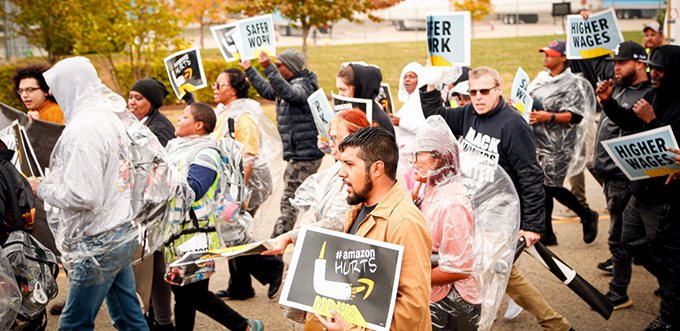Peak Season for Action at Amazon
By Rand Wilson and Peter Olney

Could this November see the biggest coordinated international day of action at Amazon yet?
Although Thanksgiving is a unique U.S. holiday, the day after—known as “Black Friday”—is celebrated in many countries as the opening of the Christmas shopping season. In Italy, for example, merchants offer Black Friday discounts that fill their stores with the same bargain-hungry shoppers as in the U.S.
That’s why three Italian trade union federations chose it as a strategic day in 2017 to strike Amazon’s million-square-foot distribution center in Castel San Giovanni, near Piacenza in Northern Italy.
The San Giovanni facility opened in 2015. Two years later, half of the 1,650 permanent “Blue Badge” employees struck on Black Friday. While there had been some previous job actions at Amazon in Germany, this was one of the first Amazon strikes in Europe, or, in fact, anywhere.
Amazon spokespersons insisted that the strike was only 10 percent of the workforce because they love to undercount and because they factored in the 2,000 “Green Badge” employees—short-term and seasonal workers—who mostly came to work. Nevertheless, the company agreed to negotiate with the unions the following Monday.
Then management canceled negotiations and sought to reschedule the meeting unilaterally for the following January. The unions warned there would be more actions if there were no substantive face-to-face discussions by December 6. In a victory for the unions, on December 5, Amazon management agreed to meet and subsequently bargained improvements in working conditions.
The Italian actions and later Amazon strikes in Germany and Poland were hugely inspirational to us (in fact Peter Olney was in Italy during the Castel San Giovanni strike). We believed they would help motivate more worker organizing in the U.S. and thus began urging young activists to get jobs at Amazon.
COALITION TARGETS AMAZON
Since 2017, coordinated international actions targeting Amazon have increased. In 2019, UNI Global Union and Progressive International launched Make Amazon Pay, a coalition uniting over 70 trade unions, civil society organizations, environmentalists, and tax watchdogs. The coalition’s unifying demands are that Amazon pay its workers fairly and respect their right to join unions, pay its fair share of taxes, and commit to real environmental sustainability.
Last November, peak season actions took place in 25 countries around the world. However, past participation by unions and organizations in the U.S. has been modest at best.
The organizing successes at Amazon facilities—including winning a National Labor Relations Board vote at a Staten Island Fulfillment Center in April—and the numerous walkouts over pay and conditions in Amazon facilities from Maryland to California reflects a new spirit of labor militancy in the U.S. Building on that opportunity, UNI Global recently convened a meeting of rank-and-file Amazon organizers and union leaders to begin planning for Black Friday actions in the U.S. We hope this will lead to high-profile walkouts and rallies targeting U.S. Amazon facilities on November 25.
In addition to the substantial increase in worker organizing at Amazon, other factors could contribute to broader support and participation in U.S. Black Friday actions this year:
- The Teamsters have already begun a contract campaign for their 340,000 members at UPS;
- Members of the International Longshore and Warehouse Union (ILWU), the West Coast dockworkers union, are working without a contract as negotiations continue with the Pacific Maritime Association;
- Railroad workers are voting on national agreements bargained with the big freight railroads. The membership of the Brotherhood of Maintenance of Way Employees, the third largest rail union, just voted to reject the contract and could strike as early as November 19. Votes in the two largest unions, representing engineers and conductors, are pending. If members vote to reject these agreements, it could lead to a dramatic work stoppage affecting the 40 percent of U.S. GNP that travels on rail;
- The increased support for unions generally—thanks to the courageous organizing by Starbucks and Amazon workers, prominent strikes by Nabisco, Frito-Lay, Kellogg’s, and John Deere workers, and the respect for the role of essential workers during the pandemic—means that Black Friday protests will be perceived as part of a much broader labor movement.
Could these combined developments lead to a “Peak Season” moment when logistics workers at many companies across the entire sector take action together? Imagine Teamster drivers and warehouse workers protesting at UPS barns, then marching to nearby Amazon facilities to support walkouts by workers there. Or dockworkers and railroad workers taking their message to workers at intermodal facilities that handle Amazon freight. Or thousands of warehouse and delivery workers at smaller companies using Black Friday as a strategic opportunity to dramatize their power in the supply chain and begin forming their own unions.
While much of the above may only be a dream for this November, it’s the direction that the labor movement is headed in. For now, it’s realistic to envision U.S.-based peak season actions dovetailing nicely with Make Amazon Pay activities around the world. Logistics workers of the world, unite!
.
This piece is also running in Labor Notes
…